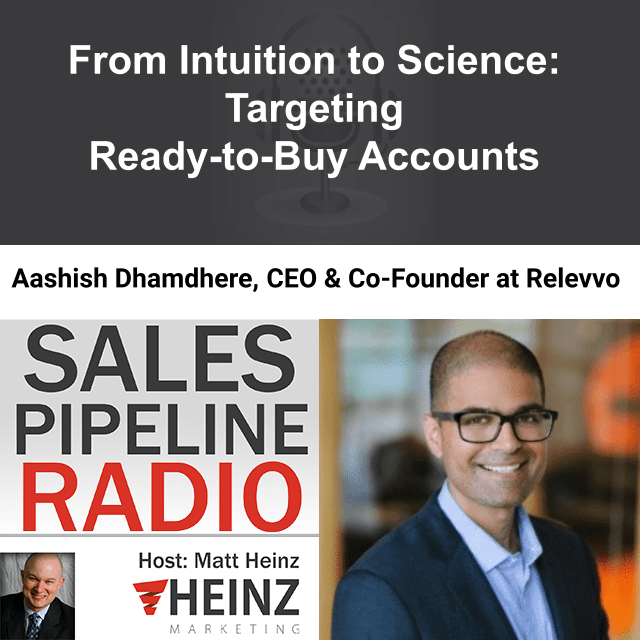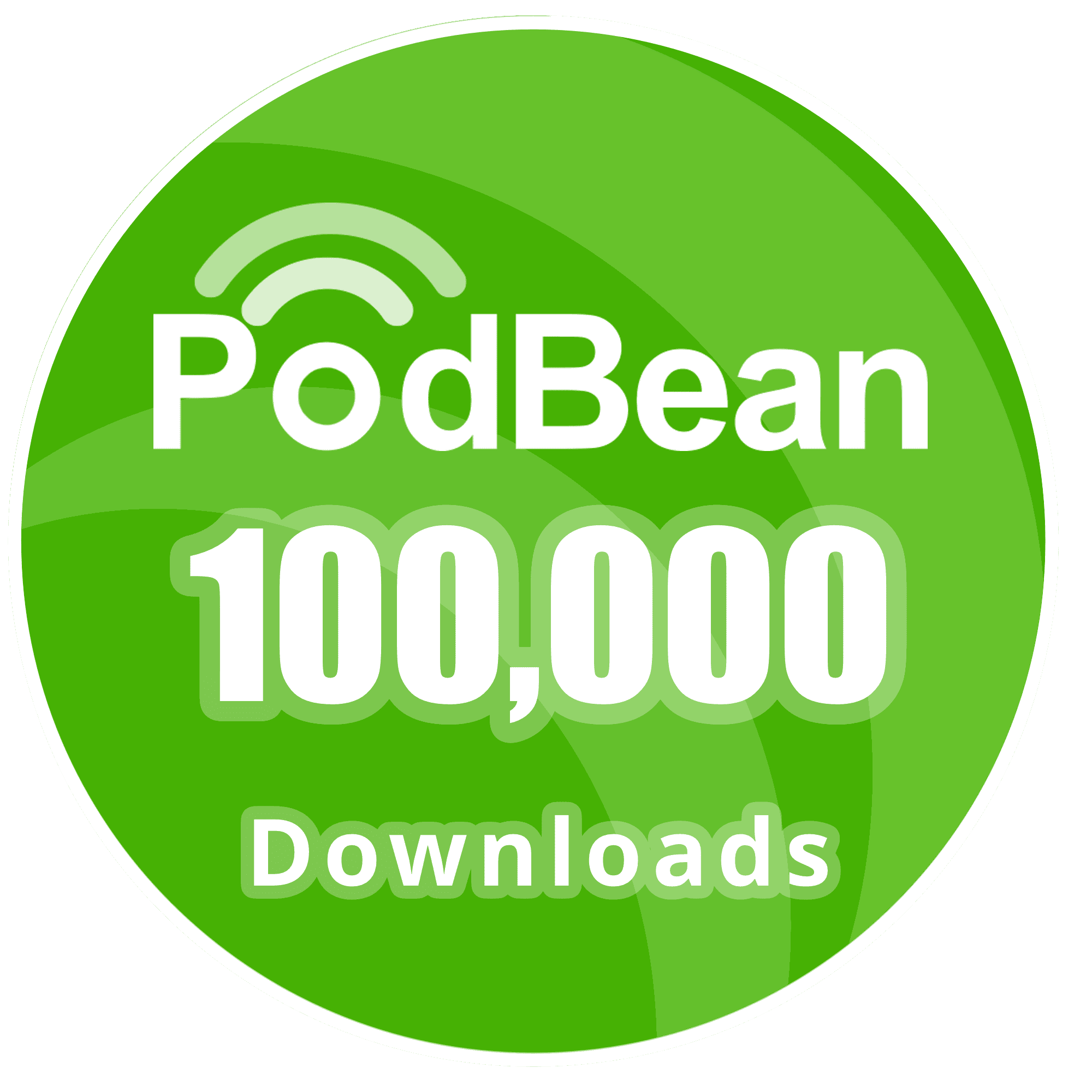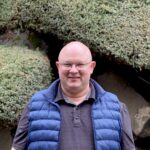Sales Pipeline Radio, Episode 330 Q & A with Aashish Dhamdhere @dhamdhere

By Matt Heinz, President of Heinz Marketing
If you’re not already subscribed to Sales Pipeline Radio or listening live every Thursday at 11:30 a.m Pacific on LinkedIn (also on demand) you can find the transcription and recording here on the blog every Monday morning. The show is less than 30 minutes, fast-paced and full of actionable advice, best practices and more for B2B sales & marketing professionals.
We cover a wide range of topics, with a focus on sales development and inside sales priorities. You can subscribe right at Sales Pipeline Radio and/or listen to full recordings of past shows everywhere you listen to podcasts! Spotify, iTunes, Blubrry, Google Play, iHeartRADIO, Stitcher and now on Amazon music. You can even ask Siri, Alexa and Google!
This week’s show is entitled, “From Intuition to Science: Targeting Ready-to-Buy Accounts“ and my guest is Aashish Dhamdhere, CEO & Co-Founder Relevvo
Tune in to hear more about:
- Moving from intuition to science in order to target the right people at the right time
- Best practices to leveraging prospect information in a natural way
- The importance of integration and an omnichannel approach to increase engagement
- Aashish’s decision-making process to taking the entrepreneurial journey
Listen in now for this and MORE, watch the video or read the transcript below:
Matt: All right, welcome everyone to another episode of Sales Pipeline Radio. I am your host, Matt Heinz. We are almost to the end of 2022 here. Just a couple episodes left to go before we head off into the new year, but very excited to be joining you today. Got some exciting guests, exciting topic today to cover. If you’re watching us live on LinkedIn, thank you so much for joining us in the middle of your workday. If you want to participate in today’s episode, you could be part of it. If you’ve got a comment, if you’ve got a question for myself or for our guest, Aashish, feel free to throw that into the chat. We will get to those and either bring you into the show or cite your question and make this as interactive as we can. If you’re listening or watching on demand, thank you so much for checking us out, for checking out the recordings, checking out the podcast. Every episode of Sales Pipeline Radio, past, present, and future, always available at salespipelineradio.com.
Aashish, we try to accommodate. We got video options. We got audio options. I try to make this as accessible as possible for everyone that’s listening. And every week, we’re trying to bring some of the best and brightest minds in B2B sales and marketing to the table. And today, very excited to have with us Aashish Dhamdhere. He is the CEO and Founder of Relevvo. Aashish, thanks so much for being here.
Aashish: Thank you for having me, Matt. It’s a pleasure. Thrilled to have this conversation with you. Clearly, love the content that you’ve shared. Lots of good things to talk about.
Matt: There is, and I’ve switched the words out wrong. I was so focused on making sure I got your name right. Relevvo is the name of the business. So I want to get into this. I got so many angles I want to cover here. I want to talk about sort of moving from intuition to science, in terms of who we’re targeting, how we land the plane for companies. I want to talk about your move from company executive to now starting your own business. But maybe start with the problem… because I think the ideas are, who do I target? How do I find people that are ready to buy? I mean you’ve been in this role operationally. This is a huge challenge for people.
Aashish: It’s a massive challenge. Let’s talk for just 30 seconds about what’s happening in the world. You posted about this. Zero-cost budgeting was your post. The world has changed dramatically. It’s the end of free money, which means this idea of grow at any cost, blitzscaling, all of these are concepts that we look back at fondly for at least the next two to three years. What this means is you’re going to have to be more selective. You just cannot do as much as you were doing in the past. You’re going to have to do less and you’re going to have to be smarter. And the big question that most marketers and sellers are facing is, what does that mean? Who are these companies that I should go talk to? And that’s the problem that we’ve set out to solve. It’s a problem that I faced, back to your point, myself, at companies like Apptio, Amperity, and Skilljar where you’re always trying to find your best fit prospects. The question is, how do you do it? And that’s the problem we’ve really taken on.
Matt: I think about the history of having done this sort of on the marketing and the sales side. As marketers, we’re trying to generate the best pipeline, the best leads we can for our sales counterparts, and sales is doing the same thing. It’s that age old question of, who do I call? Why am I calling? What do I talk about? I think there’s been arbitrary, if not artificial, means of defining that in the past.
Someone just raised their hand, they must be interested. Someone’s attended the last four webinars with us, they must be really qualified. Actually, they might just be really bored, but we don’t know. And so talk about the gap we’ve had. I use this phrase in the title for today, intuition to science. Talk about that gap because I think there’s still a lot of companies at various stages, both sides of that continuum today.
Aashish: Beautiful. I love that framing. Love that context. If the biggest issue that companies have had is, who are the most valuable, highest value prospects for me to go talk to. And the thing that separates your top performers on the sales side or the marketing side from the rest of the pack is they have a great intuition about what characterizes these prospects. And what it really comes down to is the intersection of where they are and the problems that you solve. So most companies, to your point, will do one of two things. They’ll look at photographic data. They’ll say, “Oh, is the company a particular size in a particular geography and a particular industry. Great, let’s go after them. They’re ICP.”
That’s necessary, but it’s not simple. Or they’ll say, “Let’s take photographic data lay it on intent.” To your point, let’s look at hand-raisers and go talk to them. Again, potentially, but what you really want to look for, is can these companies benefit from our solution? Do they have a problem, or a need, or an initiative, or a pain, or an event that’s happened there that connects them to you today? That makes them uniquely matched with the problems that you solve.
If you do that, and you lay it on the photographic data, and the intent data, you end up with something that’s incredibly powerful. That we found converts 2x better from meeting to pipeline. That leads to about a 50% jump in that first connection response rate, and that leads to 3x from a deal size perspective. All things that intuitively makes sense, but comes back to this idea of fit. Fit matters and fit is what drives selectivity.
Matt: Yeah. Talking today on Sales Pipeline Radio with Aashish Dhamdhere. He’s the CEO of Relevvo. We’re talking about precision, increased level of precision, that is accessible to companies to make sure you’re targeting the right people at the right time. I think that it almost seems like we’re seeing a shift of focus on companies from trying to drive customer action to mining data to know who to talk to because all of a sudden it seems like I don’t need the hand raiser or a KAT. I don’t need someone to attend a webinar because they’re bored. I can find information about companies and people and reach out to them at the right place at the right time with that information. That’s great. Where’s the privacy line on some of that? Is there some of the… I mean many of us have probably had that like, “Hey, I saw you were on my pricing page this morning. Do you want to talk?” That’s still creepy.
Aashish: Yes.
Matt: So, what are some best practices that you give your customers for how to leverage this information in a natural way to get a conversation going?
Aashish: Great question. If you think about the signs for fit, what we’re looking at is publicly available science. This is digital body language and most of these are at the account or the company level. So we’re looking at things like, how’s the company describing themselves on their own website? How are they describing themselves on LinkedIn? What are they posting about? If they’re a public company, what do their SSC filings look like? What are their job postings look like? And that information is super rich if you know what to look for. Especially, if you look for signals that map back to the problems that you solve. There’s this very interesting matrix that someone shared with me in personalization. There’s relevance on the one axis and personal on the other. And to your point, if you send a super personal message without it being relevant that’s just creepy.
You’re like, “Why are you even talking to me?” On the other hand, if you send a message that’s deeply and highly relevant, it doesn’t even have to be personalized, that is personalization. You have to speak persona in that case more than the person, and I think that’s the big mistake that a lot of companies make.
Matt: Just to double down on that. I think what’s happening at the company, you can’t come up with sort of one message and then it appeals to everybody. You may have a CFO and a CIO that both care about the problem, but have different ways of thinking about it or different things they care about. You may have a CIO and a system engineer, same team, but different levels, different needs that they have.
So you’re right, understanding who that person is and what they’re interested in, and doing that upfront. And then, but I assume, that the model can refine that cause I’m hoping that… And this is the whole idea of intuition, I can go take institutional knowledge of what we know about our buying committee and our buyers and start with that, but the data I would hope would improve that model over time.
Aashish: 100%. So two really important points you make. One is the iterative nature of this. And this, again, is something that’s going to become really important. Again, take the zero-cost budgeting idea. We’re going from a world where you got money to spend and then you have to defend it. You have to show the value that you got out of it. I think we’re moving to a world where you have to make a business case upfront on the value you’re going to get out of an investment before you actually do it.
How do you do it? You have to look at the impact off your investments, off your campaigns, on meetings, opportunities and revenue, deals closed. And you have to keep learning on a monthly or quarterly basis because business conditions change, competitive dynamics change, your product changes, needs of your prospects change. So you have to keep looking at these signals on those dimensions and you have to look at impact on meetings and opportunities and take that back to your targeting model and that becomes super important.
The second thing is, think about place. It’s based on the set of conditions that are true of a prospect. Different things will matter to different people in the company and you shouldn’t take a set of conditions and talk to every persona based on that. You have to look at the conditions that are uniquely suited to a specific persona. CIO versus CFO, the security architect versus the CISO, or the head of demand gen versus the CRO. That’s why it’s important to not just match these signals, but to have plays that you’re orchestrating based on those signals that make it relevant.
Matt: Well, and those plays aren’t, hey, let’s trigger a Marketo sort of email sequence. I think increasingly we’re seeing the successful plays are those that are orchestrated across channels and across teams. Talk about the importance of integration and having more of an omnichannel, an omni-department approach to your follow-up so that you have, not just that you’re surrounding people with multiple channels and having a better chance of engaging with them but driving consistency of message and approach to improve response.
Aashish: This is another one of those things where we’ve talked about sales marketing alignment for as long as I’ve been doing this. You’ve written about it for as long as you’ve been doing it and it feels like we’re at an inflection point where it’s gone from something you complain about to something that’s not optional at all. Again, if you’re doing zero-cost budgeting, if you’re fighting for every dollar, and if you want it to go the extra mile, you have to have the sales and marketing teams targeting a similar set of accounts.
It doesn’t have to be at the same time, but the profile that has to be… The fit scores and the fit characteristics have to match across sales and marketing. In many cases, this is also where intent is good. You absolutely should look at intent, but it might be too late if somebody’s already researching something. You may want to catch them before they start showing intent. And that’s the difference between sales and marketing in many ways. Where you have to figure out how do you influence the buying journey of the right people and the right companies when there is fit, but there is no intent? And then what do you do when there’s intent and fit, both, and how do you follow up on that? This is why it’s extremely important that this fit model is company-wide. That it’s really the organizational view. That it’s really the company-wide view as opposed to a functional view. The actions and the campaigns will vary based on the team and who you are and what you’re doing, but you’re all singing from the same playbook and you’re running different plays that map back to these conditions.
Matt: So let’s talk, let’s shift gears a little bit and I want to talk about sort of the entrepreneurial journey here because I mean you’ve had a long career working at Microsoft and a number of other sort of large enterprise tech companies. And a couple years ago… We’re coming up on your two-year anniversary of sort of hanging up a shingle and sort of saying, okay, I’m going to do this. I mean, and we talked to a lot of people that whether it’s like I got a product idea, or I think I want to be a consultant to say they want to do that and they don’t have a history of doing it. Or they don’t necessarily come from… Like I don’t come… I come from a very risk adverse family of Midwestern parents who were not, did not… This would’ve been very terrifying. So talk a little bit about that decision-making process and what drove you to step out and have the confidence and courage to do it?
Aashish: That’s such a great question. And Matt, I would bet… You speak about your family being risk averse. I grew up in India. My dad’s a surgeon, very risk averse. I grew up in India in the 80s and 90s when really the only two career options were, go be an engineer or go be a doctor. Being an entrepreneur was so outside the realm of the possible you didn’t think about it. But two big factors drove this journey. The first is, I kept running into this problem over and over and over again where it felt like depending on the quarter you’re wasting your money, 80% of your money, chasing accounts that you really shouldn’t be chasing at all, and I kept looking for a systematic solution to this. You can solve this using human beings to some degree in small subscale bases when you’re early in the journey of the company. It becomes really hard as the company grows. And so the problem kept staring at me. Faced this problem at Apptio, faced it at Amperity, faced it again at Skilljar. So that was one bit. The other bit was really thinking about if this problem keeps speaking to you over and over again can you ignore the siren call of the problem? Number one.
Number two, goes back to purpose. Is where do you find purpose, and meaning, and energy in your life? And I came to realize that it was my career journey was going companies that were smaller and smaller in size and earlier and earlier in stage. So it felt like we knew… The entrepreneurial journey is not easy. Nobody would ever say that it’s easy.
The question you have to ask yourself is, from a regret minimization perspective, when it’s time, when all is done, life is short, when you’re about to pack it in, what will you regret the most? And I knew that if I didn’t try to build this I would regret it and that was the biggest driver. And I felt like this thing needed to exist.
Matt: I love that answer. I have yet to talk to very many people that feel like they were completely ready when they started a business or stepped out and did it. I tell people all the time, I said, “There’s three things in my life that if I would’ve waited until I was ready I would never have done. It’s get married, have kids, start a business.”
Aashish: So true.
Matt: I mean secret time, I’m not ready for any of those now, but you just sort of plow forward and figure it out as you go. And so two years in, what are some things you’ve learned? What are some things that you wish you could’ve told the two years ago self as you got this started?
Aashish: I’ll just say that on your point about making the leap. You always want to make the leap when you know there’s something on the other side, but that’s not how it works. It has to be a leap of faith. What happens, interestingly, is you make the leap and there is something on the other side and you roll with it. Lessons learned, that’s a really good question. I’d say number one, lean on friends, lean on family, get advice. You don’t have to have all the answers. You’re never going to have all the answers. Talk to people who have the answers. Talk to people and get a lot of different opinions. Here’s the other part of that advice though. Don’t expect them to give you a right answer to your problem ever. They’re going to give you data points. They’re going to give you input. You still need to process those to figure out what makes the most sense for what you need to do. So I should say that’s number one.
Number two is, there’s this really sort of woo-woo concept. I mean, I think Einstein talked about this. He said, “The hardest thing to believe in is the idea of a friendly universe.” That the universe is trying to give you exactly what you need at every given point in time, and I think that is the entrepreneurial journey every single day.
Matt: Yeah.
Aashish: Everything that happens you have to almost train yourself to not look at it as good or bad, but as fuel for what you want to do next. So it’s this intersection of stoicism and sort of Einstein where you’re saying this happened, we know what we need to do, how can we take this and work it? And I think great entrepreneurs that’s what they do day in and day out, day in and day out, and the resilience and the grit goes with it.
Matt: I love that. It’s such a good answer. And I know we’re running up on time, but I just want to reiterate three things that you said there because I’ve been doing this now a little over 14 years and it’s exciting and terrifying on a regular basis, but I’m addicted to it and I can never take a real job again. Three things, one is the community. Find your tribe of people that are going through a similar experience. If you’re starting something from scratch, there’s the super early stage startup groups. I’m a member of a group called EO, Entrepreneurs’ Organization, for companies that are a little bit bigger, but wide variety of industries, but shared experiences and that is super, super valuable. Your point about some people may want to give you advice, but the best information is an experience. It’s an experience share. I went through something similar and here’s what I went through. And having that from someone that has been on part of that journey with you or that similar journey to what you’re doing is important. And the last is, I think you mentioned a version of, what I say is like there is no destination. This is just a journey. The job is not to sort of focus on an endpoint. The job is to learn and to continue to try to get better. And it’s not always going to go the way you want, but you learn every step no matter what happened. But that is it. That is it, is the journey. If you can enjoy that and if you can benefit from that, and if you can help people around you be better, all the better. So I don’t know, I didn’t mean to get on my soapbox there, but-
Aashish: Well said. It’s one of those things, but it seems… It’s simple, but it’s not easy. You just have to keep doing it.
Matt: Oh, it’s easy for us to sit here on a podcast and talk about it, but as soon as we hang up we got to go back to a hard business to run in a tough economic condition. I mean all this stuff still exists and so no, easier said than done. But Aashish, thank you so much for joining us today. Where can people learn more about Relevvo?
Aashish: Matt, thank you so much for having me. Relevvo.com is where we’re at or you can follow me here on LinkedIn and learn more about us. We post all the time and we look forward to hearing from you. Please, if you have questions, comments, suggestions, we’d love to connect.
Matt: Awesome, thank you. So Relevvo that’s one L and two Vs, relevvo.com. Thanks again, Aashish. Thank you to Kat and to sharing to other folks who are watching us live today. If you’re watching this on demand thanks very much for checking it out. We’ll be here next Thursday again, 11:30 A.M. Pacific, 2:30 Eastern. My name is Matt Heinz. On behalf of Aashish and our team, thanks so much for watching another episode of Sales Pipeline Radio.
Aashish: Thank you.
Listen to the Latest Episodes:






